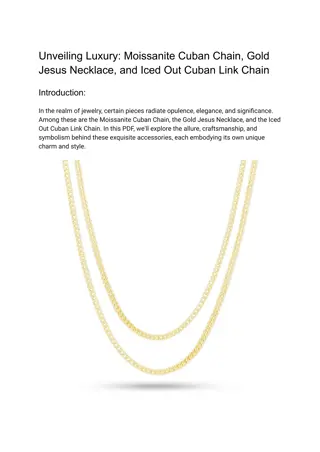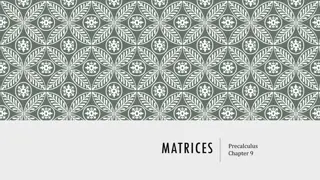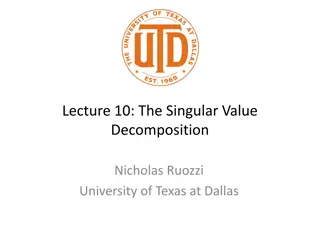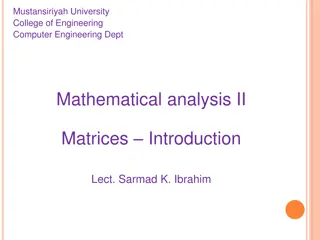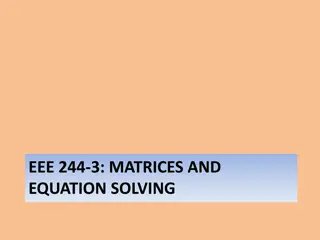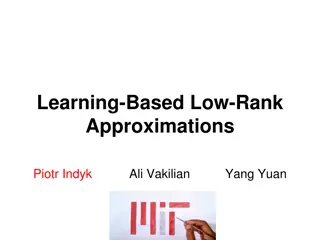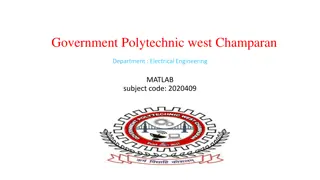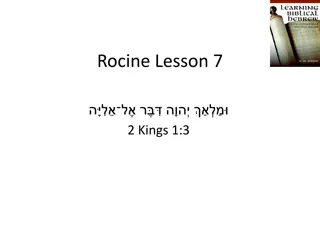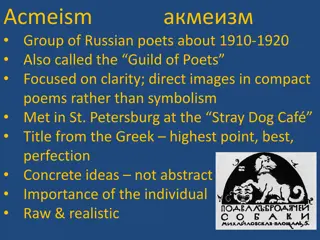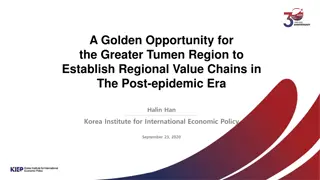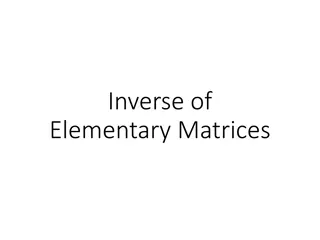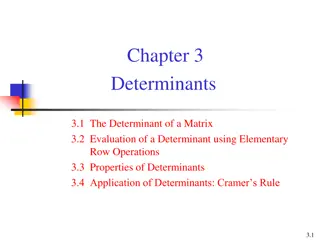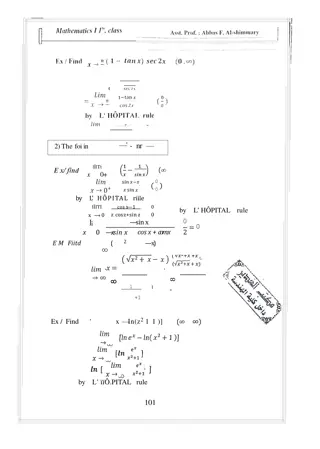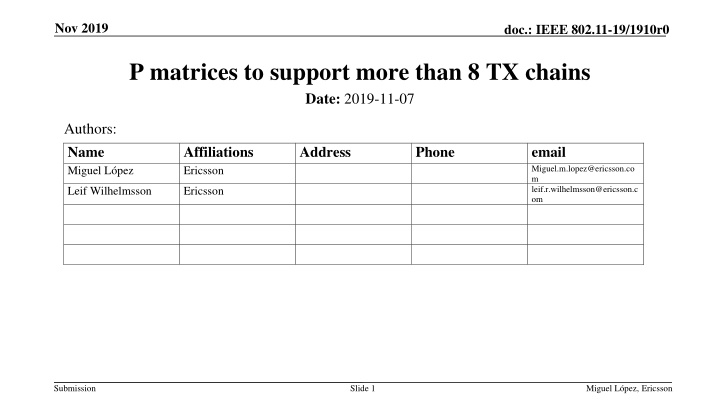
Discussing P-Matrices in IEEE 802.11-19/1910r0 for Enhanced High Throughput
This contribution explores the use of P-matrices with zero entries in IEEE 802.11-19/1910r0 to support more than 8 TX chains. It highlights the advantages of considering these matrices in Enhanced High Throughput (EHT) scenarios, showcasing their benefits for various MIMO configurations. The discussion covers the reuse of standardized P-matrices as building blocks, enabling joint sounding in scenarios where subcarrier interleaved LTFs may not suffice. The complexity reduction at the receiver with P-matrices containing zero entries is emphasized, especially in cases where full resolution is required in the frequency domain.
Download Presentation

Please find below an Image/Link to download the presentation.
The content on the website is provided AS IS for your information and personal use only. It may not be sold, licensed, or shared on other websites without obtaining consent from the author. If you encounter any issues during the download, it is possible that the publisher has removed the file from their server.
You are allowed to download the files provided on this website for personal or commercial use, subject to the condition that they are used lawfully. All files are the property of their respective owners.
The content on the website is provided AS IS for your information and personal use only. It may not be sold, licensed, or shared on other websites without obtaining consent from the author.
E N D
Presentation Transcript
Nov 2019 doc.: IEEE 802.11-19/1910r0 P matrices to support more than 8 TX chains Date: 2019-11-07 Authors: Name Miguel L pez Affiliations Ericsson Address Phone email Miguel.m.lopez@ericsson.co m leif.r.wilhelmsson@ericsson.c om Leif Wilhelmsson Ericsson Submission Slide 1 Miguel L pez, Ericsson
Nov 2019 doc.: IEEE 802.11-19/1910r0 Abstract This contribution discusses the use of P-matrices containing zero entries. It is shown that it is advantageous to consider these matrices in EHT Submission Slide 2 Miguel L pez, Ericsson
Nov 2019 doc.: IEEE 802.11-19/1910r0 Recap During the standardization of 802.11ax it was shown that support for both 4x-LTF and 1x-LTF is beneficial The use of 4x-LTF is gainful when employing higher order modulations [1] The use of 1x-LTF is advantageous for UL-MU-MIMO [2] It has been argued in TGbe that joint channel sounding is beneficial to support multi-AP joint transmission [3] It has been proposed to use sub-carrier interleaved LTFs [3] to support a global number of antennas exceeding 8 During the question period following the presentation of the contribution [4] it was pointed out that subcarrier interleaved LTFs can also be used to support MIMO with up to 16 spatial streams. Submission Slide 3 Miguel L pez, Ericsson
Nov 2019 doc.: IEEE 802.11-19/1910r0 Remarks on subcarrier interleaved LTFs The contributions [1], [2], [3] indicate that subcarrier interleaved LTFs is a potentially useful technique when two APs are coordinated (RX estimates frequency domain channels coefficients spaced 156.25 kHz) Subcarrier interleaved LTFs may not be enough to support all relevant use cases There may be under-sampling of the channel in the frequency domain, which may adversely impact performance for time dispersive channels such as TGnD, or when high order modulations (e.g. 256/1024/4096 QAM) are used, as shown in [1] Subcarrier interleaved LTFs may not support some multi-AP configurations when the global number of TX antennas is large. For example 3 APs with 16 TX each would require the RX to estimate frequency domain channel coefficients spaced 468.75 kHz and interpolate. Submission Slide 4 Miguel L pez, Ericsson
Nov 2019 doc.: IEEE 802.11-19/1910r0 P-matrices with zeros In this contribution we discuss P-matrices with zeros (i.e. some of the entries are zero) P-matrices with zeros, having orders > 8, or even > 16, can be easily constructed from smaller matrices The already standardized P matrices can be re-used as basic building blocks These P-matrices can be used for joint sounding when the global number of antennas is too large for subcarrier interleaved LTFs These P-matrices can be used in the cases where full resolution is needed in the frequency domain (e.g. when 4x-LTFs are the best choice) These P matrices give reduced complexity at the receiver, compared to P-matrices with only non-zero entries P-matrices with zeros can be used together with subcarrier interleaved LTFs Submission Slide 5 Miguel L pez, Ericsson
Nov 2019 doc.: IEEE 802.11-19/1910r0 P-matrices with zeros: An example ? Butterfly of ??? There are many different ways to generate P- matrices with zeros. We illustrate one procedure by means of a relevant example. 802.11 has standardized a P-matrix ??of order 8. If ??is the identity matrix of order 2 then the matrix ??? its entries are zeros (here denotes the Kronecker product) The matrix ??? Multiplication of a vector by ??? performed more efficiently than Hadamard/Walsh Transforms or FFT of order 16 ?= ?? ??has order 16, and half of ?is orthogonal ?can be minus plus Submission Slide 6 Miguel L pez, Ericsson
Nov 2019 doc.: IEEE 802.11-19/1910r0 Problem of P-matrices with zeros ?described in slide 6 is One problem inherent to the use of the matrix ??? that the presence of each zero implies that one TX chain will be silent during the transmission of one LTF power of up to 3 dB relative to P-matrices with only unit amplitude entries . In this example, there is a loss of TX Submission Slide 7 Miguel L pez, Ericsson
Nov 2019 doc.: IEEE 802.11-19/1910r0 Solving the power loss problem of P-matrices with zeros An easy solution to this problem, for the example in slide 6, is to use one matrix for the even subcarriers and a different matrix for the odd subcarriers. Subcarrier interleaved LTFs are a special case with zeros as described in this contribution is a generalization of the technique used in subcarrier interleaved LTFs Variants of the procedure can be used for all orders (e.g. 8, 10, 12, 14, 16, 32, 48 etc) The method is easy to generalize if it is desired/needed to use a different P matrix every 3rd/4th/5th/6th/... subcarrier The use of P matrices Submission Slide 8 Miguel L pez, Ericsson
Nov 2019 doc.: IEEE 802.11-19/1910r0 Solving the power loss problem of P-matrices with zeros ?by Going back to the example in slide 6: Generate a second matrix ??? flipping the rows of ??? ?? ? of ??? ??? Odd subcarrier apply ? ??? Even subcarrier apply ? ??? There s no need to implement multiplication by ??? perform multiplication by ??? Note: There are many alternative ways to generate P matrices similar to ?upside down, so that row ? in ??? ?(? ? ??). In the Matlab programming language ?=flipud(??? ? ?is equal to row ?) ? ?at the RX. Instead ?and read the result backwards ?= ?? ? ? ? ?and ??? ?from smaller matrices. For example ??? ??? also works ? Submission Slide 9 Miguel L pez, Ericsson
Nov 2019 doc.: IEEE 802.11-19/1910r0 Remarks ?and ??? ?have full rank, the RX can estimate the channel at Since both ??? both even and odd subcarriers RX complexity is reduced when compared to the use of P matrices of the same order and without zero elements We have given one example to illustrate the proposal. It is straightforward to generate many more examples to fit the requirements of different use cases regarding number of TX antennas, complexity reduction at RX and/or resolution of the channel estimates in the frequency domain The P-matrices are applied only to non-pilot subcarriers Submission Slide 10 Miguel L pez, Ericsson
Nov 2019 doc.: IEEE 802.11-19/1910r0 Summary It has been pointed out that P matrices with zeros of any order can be generated from smaller matrices and thus allow the re-use of the already standardized P matrices P matrices with zeros can be used to reduce the complexity of RX processing. History shows that 802.11 PHYs have a very long life and what used to be top of the line a few years ago is today heavily optimized for use in IoT and other applications that require power efficiency and low cost (e.g. 802.11n) P matrices with zeros can give the maximum possible resolution for frequency domain channel estimation Submission Slide 11 Miguel L pez, Ericsson
Nov 2019 doc.: IEEE 802.11-19/1910r0 Straw poll Do you agree that EHT should support the estimation of frequency domain channel coefficients with a resolution of 78.125 kHz when the global number of antennas exceeds 8? Y/N/A Submission Slide 12 Miguel L pez, Ericsson
Nov 2019 doc.: IEEE 802.11-19/1910r0 References [1] Kome Oteri et al., Performance of 1x 2x and 4x HE LTF IEEE 802.11- 15-0569-01-00ax, May 2015 [2] Hongyuan Zhang et al., 1x HE LTF for UL MU MIMO IEEE 802.11-16- 0033-00-00ax, Jan 2016 [3] Jianhan Liu et al. Joint sounding for multi-AP systems , IEEE 802.11-19- 1593-00-00be, Sep 2019 [4] Miguel L pez et al., Remarks on P matrices , IEEE 802.11-19-1555-00- 00be, Sep 2019 Submission Slide 13 Miguel L pez, Ericsson

